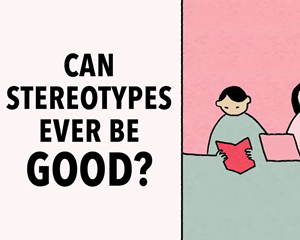In 2007, researchers surveyed over 180 teachers to understand if they held stereotypes about students from three racial groups.
在2017年,研究人员调查了超过180名教师,去了解他们是否对于来自三个不同种族的学生们持有刻板偏见。
The results surfaced several negative stereotypes,
其结果表明了几种负面的刻板偏见,
labeling Black students as aggressive and stubborn, white students as selfish and materialistic, and Asian students as shy and meek.
黑人学生标签为爱攻击的和顽固的,白人学生为自私的和物质的,亚洲学生则是害羞的和温顺的。
But regardless of the teachers' other biases,
但抛开教师们的其他偏见,
the most commonly held opinion was that Asian students were significantly more industrious, intelligent, and gentle than their peers.
最为普遍的一个看法是亚洲学生比其他的学生格外的勤勉、聪慧和温顺。
On the surface, this might seem like a good thing, or at least better than other, negative characterizations.
表面上这看似好事,或者至少比其他消极的特征要好些。
But treating this seemingly favorable stereotype as reality can actually cause a surprising amount of harm
但把这些看起来令人喜欢的刻板偏见当做现实,可能实际上会引起惊人的伤害,
to those it describes, those it doesn't, and even those who believe it to be true.
对于那些被其描述的人,没被描述的人,甚至那些信以为真的人。
This image of humble, hard-working Asians is actually well-known as the "model minority" stereotype.
这谦逊、努力的亚洲人形象实际上以“模范少数族裔”的刻板印象为人所知。
Versions of this stereotype emerged in the mid-20th century to describe Chinese Americans.
这种刻板偏见的的各种版本在二十世纪中期出现,用来描述美籍华人。
But following World War II, the label became commonly used to claim that
但在第二次世界大战之后,这个标签更常用来表明
Japanese Americans had overcome their mistreatment in US incarceration camps, and successfully integrated into American society.
美籍日本人在美国集中营被虐待之后重获新生并成功融入美国社会。
Former incarcerees were praised as compliant, diligent, and respectful of authority.
之前被囚禁者被称赞为顺从、勤勉、尊重权威。
In the following decades, "model minority" became a label for many Asian populations in the US.
在接下来的几十年中,“模范少数族裔”成为了在美国的许多亚裔人口的标签。
But the truth behind this story of thriving Asian Americans is much more complicated.
但在亚裔美国人蒸蒸日上的故事背后,其现实更加复杂。
During World War II, the US government tried to "Americanize" incarcerated Japanese Americans.
在第二次世界大战期间,美国政府曾试图“美国化”被囚禁的美籍日本人。
They did this through English language classes, patriotic exercises, and lessons on how to behave in white American society.
他们通过英文课程、爱国活动和课程来教授如何在白人美国社会正确表现。
When incarcerees were released, they were instructed to avoid returning to their own communities and cultural practices, and instead, integrate into white society.
当囚犯们被释放时,他们被教育不要返回他们自己的社区和文化环境,而是要去融入白人社会。
But after decades of anti-Asian policies and propaganda, white Americans had to be persuaded that Japanese Americans were no longer a threat.
在几十年反亚裔的政策和宣传之后,美国白人必须被说服美籍日本人对他们来说不再是威胁。
So the government organized media coverage to transform the public perception of Japanese Americans from suspected traitors to an American success story.
所以政府组织媒体报道,让公众对日裔美国人的认知从可疑的叛徒转变为美国成功故事。
In fact, the phrase "model minority" was coined by one such article from 1966.
事实上,“模范少数族裔”的说法是在1966年的一篇文章中被创造出来的。
But this article, and others like it, didn't just cast Asian Americans as an obedient and respectful "model minority."
但是这篇文章,和那些喜欢它的人,不仅仅把亚裔美国人打造成为顺从和谦恭的“模范少数族裔”。
They also criticized so-called "problem minorities," primarily Black Americans.
他们还批评所谓的“问题少数族裔”,主要是美籍黑人。
Politicians who were threatened by the rising Civil Rights movement used this rhetoric to discredit Black Americans' demands for justice and equality.
因民权运动的兴起而感觉受到威胁的政客们用这个说辞来怀疑美籍黑人对公证和平等的需求。

They presented a fabricated story of Asian American success to paint struggling Black communities as inferior.
他们展现了一个编造出来的美国亚裔的成功故事,用来把仍在挣扎的黑人社区描绘为是更差等的。
This narrative put a wedge between Black and Asian Americans.
这种叙事方式把隔阂植入美国黑人和亚裔之中。
It erased their shared history of fighting oppression alongside other marginalized groups, and pit the two communities against each other.
磨灭了他们与其他边缘群体共同的与压迫作斗争的历史,并使这两个群体互相争斗。
In doing so, the model minority myth also enforced a racial hierarchy, with white Americans on top and everyone else underneath.
如此作为时,模范少数族裔的神话同时也强化了种族等级,白种美国人处于最高等级而其他人都在他们之下。
Certainly, many people who still believe the model minority stereotype, either consciously or unconsciously, might not agree with that idea.
当然,许多人仍然相信模范少数族裔的刻板印象,可能有意或无意地不同意那个观点。
But comparing the imagined strengths and weaknesses of racial groups places value on how well those groups meet certain standards
但当对不同种族的人群想象出来的强项和弱点进行比较,为这些种族的人能怎样达到特定标准而赋予价值
typically, standards set by a white majority.
特别是由多数族裔的白人制定标准。
In this case, the model minority stereotype suggests that marginalized groups who are compliant, gentle, and respectful of white authority are deserving of tolerance,
在这样的情况下,模范少数族裔的刻板印象暗示那些顺从的、温和的、对白种人权威谦恭的边缘化群体更值得被容忍,
while groups that challenge the status quo are not.
而那些挑战生存现状的种族则不值得。
This stereotype also negatively impacts the Asian individuals it describes.
这样的刻板偏见同样会消极地影响它所描述的亚裔个体。
According to a psychological phenomenon known as stereotype threat,
根据“刻板偏见威胁”这心理现象,
members of a group often place pressure on their individual actions to avoid encouraging negative group stereotypes.
团队成员常对他们的个体行为施压来避免助长负面的团队刻板印象。
But this phenomenon can occur around seemingly positive stereotypes as well.
但这种现象同样会发生在看似正面的刻板偏见。
The pressure associated with living up to impossibly high standards can lead to poor performance.
与难以置信的高标准所关联的压力会导致糟糕的表现。
And teachers are less likely to notice when Asian students are struggling.
当亚裔学生遭遇困难时,老师们更难注意到。
Outside the classroom, social programs catering to Asian communities are frequently overlooked or cut,
为亚裔社区服务的课外社会活动也通常被忽视或是削减,
because they're assumed to need less support than other disadvantaged groups.
因为他们被认为比其他弱势群体更不需要支持。
The favorable portrait created by this stereotype can also make it harder to recognize racially motivated violence and discrimination against Asian Americans.
被这刻板印象创造出的讨喜形象,也造成更难识别由种族冲突造成的对美国亚裔的暴力和歧视。
And since this stereotype carelessly groups all Asians under the same umbrella,
由于这样的刻板偏见无所顾忌地把所有亚裔归入同一种类,
it impacts people with various backgrounds and unique histories of discrimination.
影响了来自不同背景和特定有受歧视历史的人群。
So while the model minority label might appear to benefit Asian populations at first, in practice, it works like every other racial stereotype.
所以模范少数族裔的标签可能一开始看似对亚裔族群有益,但事实上就像其他任何一种刻板偏见一样。
It reduces a group of people to a one-dimensional image.
把一个族群简化成为单面的形象。
And that single image hinders our ability to understand the history, struggles, and triumphs of the individuals within that group.
而那个单一的形象阻碍了我们理解该群体中个人的历史、斗争和胜利的能力。
Acknowledging and challenging these labels is essential for building coalitions across communities and eliminating harmful stereotypes for good.
承认和挑战这些标签对于在社区之间建立联盟和永远消除有害的刻板印象至关重要。


